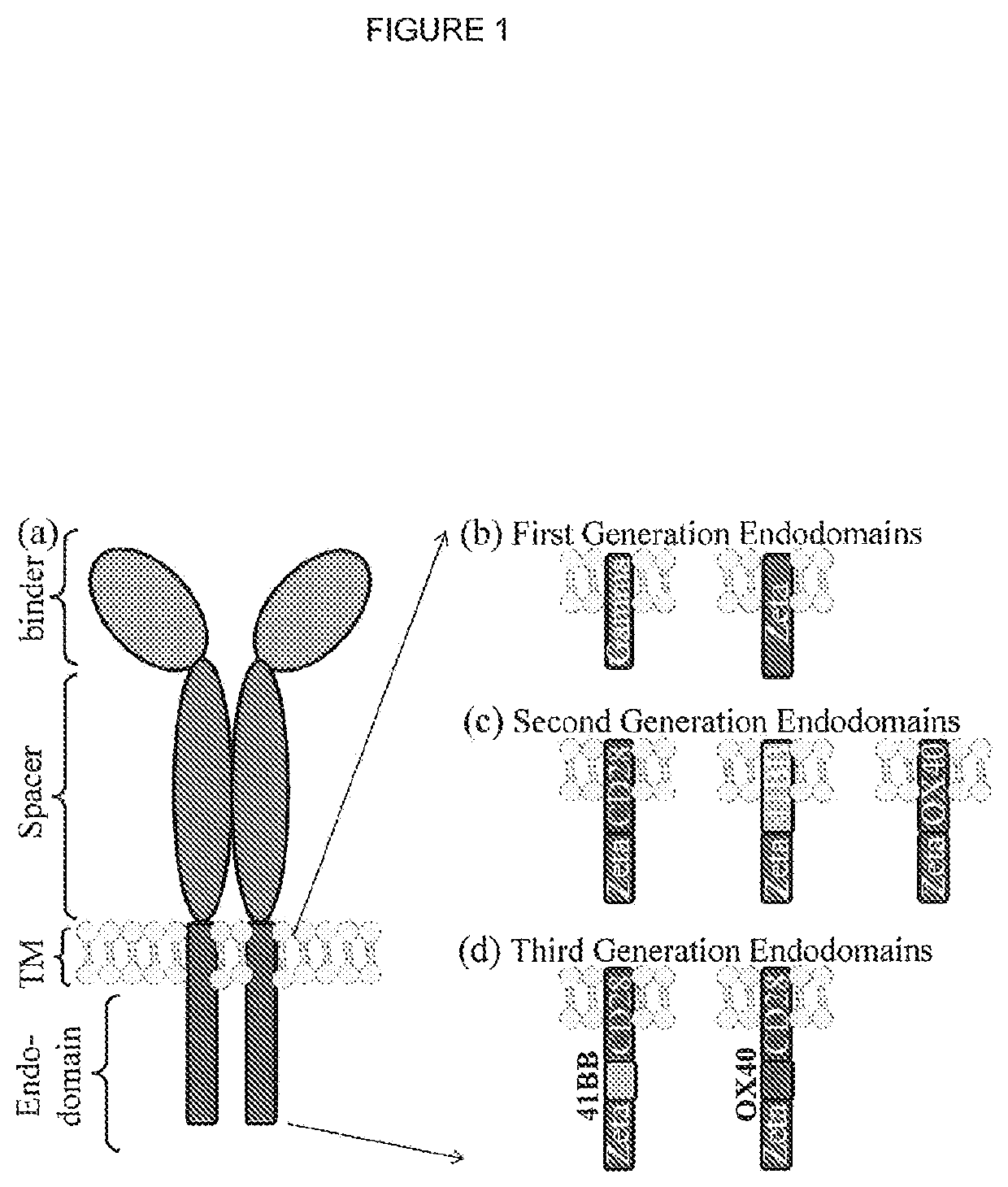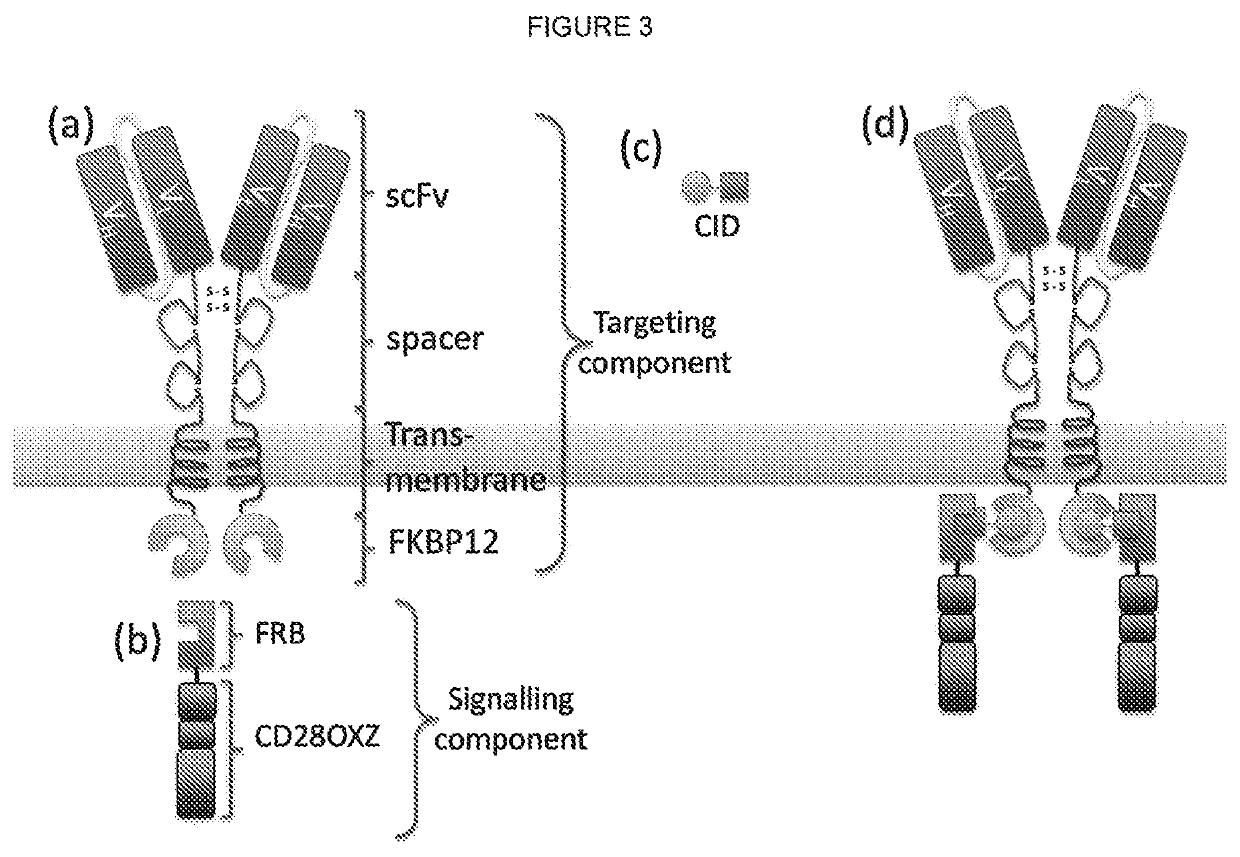Chimeric antigen receptor (CAR) signalling system
a technology of chimeric antigen receptor and signalling system, which is applied in the field of antigen receptor signalling system, can solve the problems of difficult and quite often impossible to select and expand large numbers of t-cells specific for most cancer antigens, macrophage activation syndrome (mas), and “on-target off-tumour”
- Summary
- Abstract
- Description
- Claims
- Application Information
AI Technical Summary
Benefits of technology
Problems solved by technology
Method used
Image
Examples
example 1
in-Inducible CAR System
[0226]T-cells were transduced with a retroviral vector coding for an inducible CAR detailed in FIG. 3 and the sequence of which is shown as SEQ ID 19. This inducible CAR has a single receptor component and a single signalling component. The receptor component comprises of an anti-CD19 scFv, a spacer domain derived from human IgG1, a transmembrane-domain derived from CD28 and FKBP12 as endodomain. The signalling component comprises of the FRB domain from mTOR and a signalling domain derived from endodomains of CD28, OX40 and CD3-Zeta. Expression of the CAR was determined by staining the transduced cells with a conjugated antibody recognizing the spacer domain and analysing by flow cytometry. The T-cells were incubated with either target cells expressing the cognate target CD19 in ratio of 2:1, 1:1 and 0:1 (target:effector) in the absence of rapamycin or at increasing concentrations. Signalling only occurred in the presence of both the cognate antigen and rapamy...
example 2
nducible CAR System
[0227]RSL1 is a synthetic non-steroidal analogue of 20-hydroxyecdysone (FIG. 9). It is a member of a class of insecticides known as diacylhydrazines and can function to act as a non-steroidal ecdysone agonist. These molecules induce premature moulting and larvae death but are well tolerated in vertebrates (Dhadialla et al (1998) Annu. Rev. Entomol. 43, 545-569). RSL1 has been used in artificial transcription switches (Lessard et al (2007) The Prostate 67, 808-819) whereby a two-protein transcription switch consisting of a fusion between the ecdysone receptor (EcR) and GAL4, and the retinoid X receptor (RXR) and VP16. In such systems, EcR is modified to interact specifically with RSL1 (Kumar et al (2004) J. Biol. Chem. 279, 27211-27218), and RXR is chimeric comprising of helices 1-8 replaced with helices 1-8 of human RXRβ, and helices 9-12 from Locusta migratoria RXR.
[0228]The present inventors have constructed a split CD19 CAR based on the CD19 system described in...
example 3
-Inducible CAR System
[0229]AP1903 is a synthetic chemical inducer of dimerization which binds to two mutated FKB12 domains (Clackson et al (1998). Proc. Natl. Acad. Sci. U.S.A 95, 10437-10442). An inducible CAR was developed based on this system, using the modified FKBP12 domains to constitute the heterodimerization domain of both the antigen recognition component and signalling component in the framework as described in Example 1 with the antigen recognition domain and the signalling domain co-expressed with a FMD-2A like sequence (FIG. 11a and SEQ ID No. 24). The FKBP12 domains were codon-wobbled to prevent homologous recombination. T-cells were transduced with this construct and challenged with target cells which were CD19 negative or positive.
[0230]T-cells responded only to CD19 positive targets in the presence of AP1903 (FIG. 11b). At very high concentration of dimerizer, signalling was inhibited likely due to saturating conditions where the stoichiometry favours one FKBP12 bin...
PUM
| Property | Measurement | Unit |
|---|---|---|
| nucleic acid | aaaaa | aaaaa |
| concentration | aaaaa | aaaaa |
| affinity | aaaaa | aaaaa |
Abstract
Description
Claims
Application Information
 Login to View More
Login to View More - R&D
- Intellectual Property
- Life Sciences
- Materials
- Tech Scout
- Unparalleled Data Quality
- Higher Quality Content
- 60% Fewer Hallucinations
Browse by: Latest US Patents, China's latest patents, Technical Efficacy Thesaurus, Application Domain, Technology Topic, Popular Technical Reports.
© 2025 PatSnap. All rights reserved.Legal|Privacy policy|Modern Slavery Act Transparency Statement|Sitemap|About US| Contact US: help@patsnap.com



